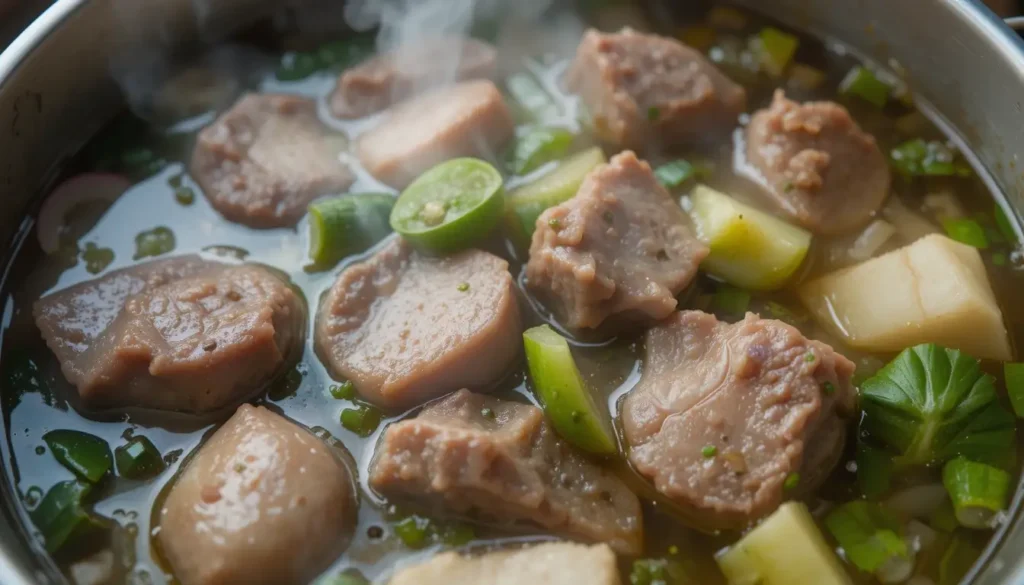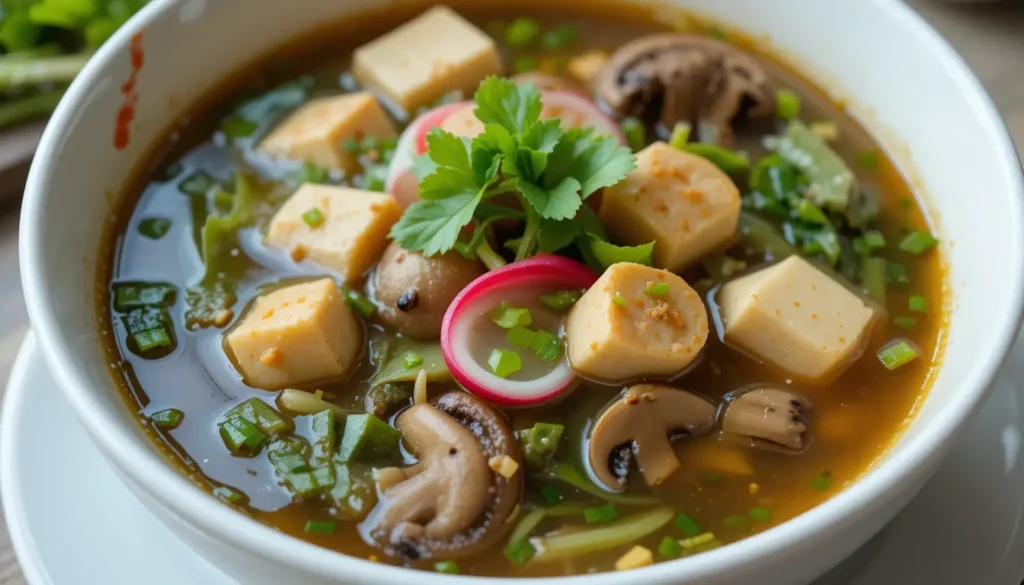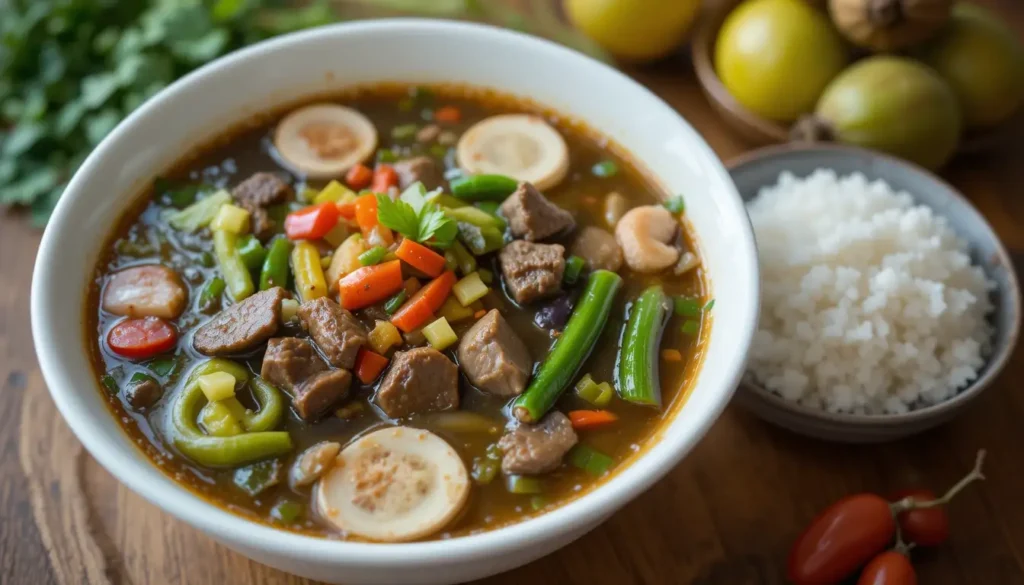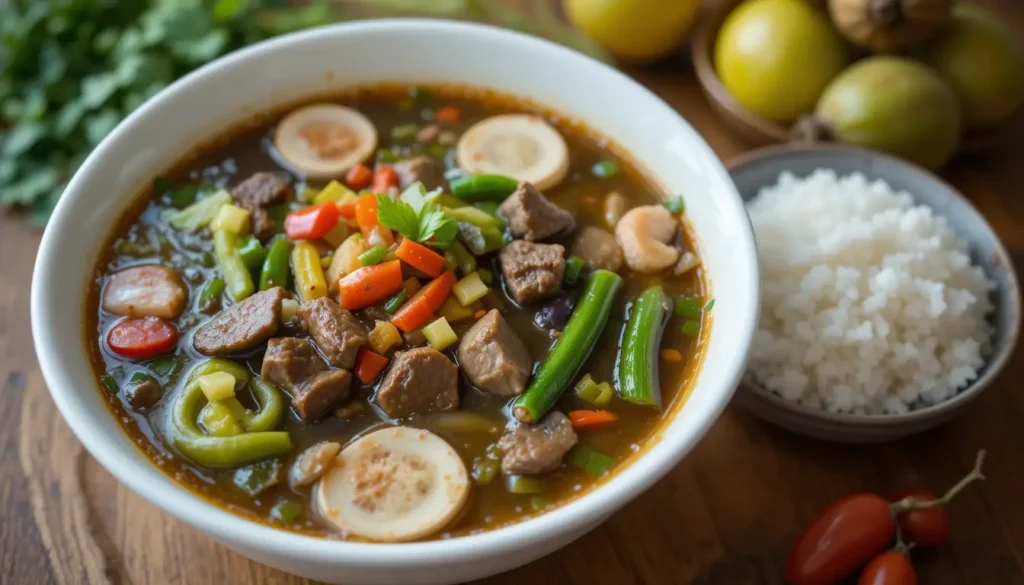Sinigang, a quintessential dish in Filipino cuisine, is much more than a simple soup. Known for its distinctive sour flavor and nourishing ingredients, Filipino sinigang holds a cherished place in Filipino households. This dish combines a protein base with a variety of vegetables, all simmered in a tangy broth often flavored with tamarind, raising the question, “Is Filipino sinigang healthy?”
Beyond its comforting taste and cultural importance, sinigang sparks curiosity about its health benefits. Can a dish so flavorful also be good for you? The answer lies in its ingredients and preparation methods. This article will delve into the nutritional aspects of sinigang, its potential health benefits, and how it can be customized to meet specific dietary needs.
Table of Contents
Nutritional Benefits of Sinigang
A Balanced Meal in a Bowl
One of the key advantages of sinigang is its balance of macronutrients. With a protein source such as pork, fish, or shrimp and an abundance of vegetables like okra, radish, and eggplant, sinigang delivers a wholesome combination of proteins, vitamins, minerals, and dietary fiber. The dish is often paired with rice, making it a complete meal that satisfies hunger and fuels the body.
Immune-Boosting Ingredients
Sinigang is also rich in nutrients that support the immune system. Tamarind, the most common souring agent, is loaded with antioxidants, which help combat free radicals and reduce inflammation. Vegetables like kangkong (water spinach) and tomatoes add vitamin C, an essential nutrient for immune health.
Core Ingredients of Sinigang

Protein Sources in Sinigang
Sinigang’s protein source is central to its flavor and nutritional profile, as it serves as the foundation of the dish’s richness and heartiness. While pork is a traditional choice, beef brings a robust, savory flavor that enhances the tangy broth. For those wondering, “Is Filipino sinigang healthy?”, beef options like shank, short ribs, or brisket offer nutritional benefits. These cuts release collagen during cooking, giving the soup a silky texture while contributing essential nutrients. They also absorb the sour and savory flavors of the broth, creating a satisfying harmony in every bite.
Beef is not only delicious but also nutritionally valuable. It is packed with high-quality protein that aids in muscle repair, tissue regeneration, and overall body maintenance. Additionally, beef is an excellent source of essential nutrients such as iron, which supports oxygen transport in the blood, and zinc, which bolsters the immune system. Its B vitamins, particularly B12, play a crucial role in energy production and maintaining healthy nerve functions.
For a healthier sinigang, you can choose leaner beef cuts like sirloin or tenderloin to reduce fat content. Trimming visible fat before cooking also minimizes saturated fat while retaining the dish’s hearty appeal. Combining beef with a generous mix of vegetables further enhances the dish’s nutrient profile, ensuring a balanced and wholesome meal.
The Power of Vegetables
Sinigang is celebrated for its generous use of vegetables, each contributing unique nutrients:
- Radish (Labanos): Low in calories and high in fiber, radish supports digestion and provides a mild, peppery flavor.
- Okra: A good source of soluble fiber, okra helps regulate blood sugar and supports gut health.
- Eggplant: Rich in antioxidants like nasunin, eggplant promotes heart health and fights free radicals.
- Kangkong (Water Spinach): This leafy green is packed with iron, calcium, and vitamins A and C, boosting bone health and immunity.
- String Beans: A versatile vegetable, string beans add crunch and deliver vitamins C and K along with dietary fiber.
Incorporating a variety of vegetables in sinigang not only enhances its taste and texture but also ensures a meal rich in vitamins, minerals, and antioxidants.
The Sour Component
The defining feature of sinigang is its sour broth, traditionally made with tamarind pulp. Tamarind not only enhances the flavor but also highlights why people ask, “Is Filipino sinigang healthy ?” It contains healthful compounds like polyphenols and flavonoids, which have antioxidant and anti-inflammatory properties. Tamarind is also a good source of magnesium and potassium, both essential for cardiovascular health.
For those seeking alternatives to tamarind, other souring agents like calamansi, green mangoes, or guava can be used. Each provides a unique twist on the classic flavor while adding its own set of nutrients.
Customization for Health
One of the best aspects of sinigang is its versatility. The recipe can be easily modified to suit various dietary preferences and needs:
- Low-Calorie Option: Replace beef with leaner proteins like chicken breast or shrimp.
- Vegetarian Option: Use tofu or legumes as the protein source while retaining the vegetable medley and sour broth.
- Low-Sodium Version: Opt for natural souring agents instead of commercial sinigang seasoning mixes, which can be high in salt.
Health Benefits of Sinigang

Packed with Essential Vitamins and Minerals
Sinigang is a nutritional powerhouse, thanks to its fresh and wholesome ingredients. The vegetables in the dish are rich in essential vitamins like A, C, and K, as well as minerals such as potassium, magnesium, and calcium. These nutrients contribute to various aspects of health:
- Vitamin A: Found in kangkong and tomatoes, it supports eye health and immune function.
- Vitamin C: Present in tomatoes and tamarind, it boosts immunity, aids in iron absorption, and promotes healthy skin.
- Potassium: Essential for heart health and fluid balance, found in radish and string beans.
Including sinigang in your diet ensures a wide array of micronutrients that support overall well-being.
Supports Digestive Health
One of sinigang’s standout health benefits is its fiber content, which answers the question, “Is Filipino sinigang healthy?” This fiber comes primarily from its vegetables. Dietary fiber is crucial for maintaining a healthy digestive system. Vegetables like okra and radish are particularly effective in promoting bowel regularity and preventing constipation. Additionally, the sour broth aids digestion by stimulating the production of digestive enzymes.
A Heart-Healthy Choice
When prepared with lean cuts of beef or other protein sources, sinigang can contribute to heart health. The potassium content in tamarind and vegetables helps regulate blood pressure, while the antioxidants in the dish combat inflammation and reduce the risk of chronic diseases. For an even healthier twist, reducing sodium by using natural seasonings instead of commercial sinigang mixes can make the dish even more heart-friendly.
Immune-Boosting Properties
The ingredients in sinigang collectively work to strengthen the immune system. Tamarind, for instance, is known for its high vitamin C and antioxidant content, which protect the body against infections. Leafy greens like kangkong add to the dish’s immune-boosting power with their wealth of vitamins and minerals.
Hydration and Electrolyte Balance
As a soup-based dish, sinigang is an excellent way to stay hydrated, particularly in warm climates. The broth also contains electrolytes such as sodium and potassium, which help maintain fluid balance and prevent dehydration. This makes sinigang a perfect recovery meal after physical activity or during illness.
Customizing Sinigang for Health
Low-Calorie Sinigang Variations
Sinigang can easily be adapted to fit a low-calorie diet. By focusing on lean proteins such as beef sirloin, shrimp, or fish and reducing the amount of oil or fat used in the cooking process, you can enjoy a lighter version of this beloved dish. Adding a higher ratio of vegetables also reduces the calorie density while enhancing the nutrient content.
For example, swapping white rice with quinoa or brown rice as a side dish adds more fiber and protein, making the meal more filling without significantly increasing calorie content.
Low-Sodium and Heart-Friendly Options
Traditional sinigang seasoning mixes can be high in sodium, which may not be ideal for those managing blood pressure or heart health. To make Filipino sinigang healthy, consider using natural souring agents like fresh tamarind, green mangoes, or calamansi. These alternatives are not only healthier but also enhance the dish’s authentic flavor.
Another way to control sodium levels is by using homemade stock instead of store-bought broth, which often contains added salts and preservatives. Fresh herbs and spices, like ginger or lemongrass, can also be used to amplify flavor without relying on salt.
Gluten-Free and Allergen-Friendly Sinigang
For individuals with dietary restrictions, sinigang can be customized to be gluten-free or allergen-friendly. Most sinigang recipes are naturally gluten-free, provided you avoid using commercial mixes with additives. Opting for fresh, whole ingredients ensures a safe and delicious meal for people with sensitivities.
Similarly, you can replace allergens like shellfish with tofu or plant-based proteins. This adjustment makes the dish suitable for more people without losing its essence.
Vegan and Vegetarian Sinigang

A plant-based version of sinigang is a fantastic way to enjoy the dish while aligning with a vegetarian or vegan diet. Replacing beef or shrimp with tofu or legumes provides protein, while the vegetable medley and sour broth remain the stars of the dish.
Incorporating mushrooms, such as shiitake or oyster mushrooms, can add a savory depth of flavor, mimicking the umami notes typically provided by meat or seafood. This version is not only healthy but also environmentally friendly.
Sinigang for Weight Management
Thanks to its high water content and fiber-rich vegetables, is Filipino sinigang healthy becomes a relevant question for those seeking nutritious meals. Sinigang can be a filling and satisfying meal that supports weight management. The abundance of vegetables not only adds bulk but also ensures you get vital nutrients without unnecessary calories. Ingredients like radish, okra, and kangkong provide dietary fiber, which aids digestion and helps you feel full longer, curbing the urge to snack between meals.
The broth-based nature of the dish makes it naturally lower in calories compared to creamy or fried meals, which are often laden with fats. Meanwhile, the combination of protein and fiber works synergistically to promote satiety, reducing the likelihood of overeating. Protein from lean beef, fish, or tofu supports muscle maintenance and repair, making sinigang a wholesome choice for active individuals.
For those focusing on weight loss, mindful portion control is key. Pairing sinigang with balanced sides, such as a small serving of brown rice or quinoa, ensures you maintain an appropriate caloric intake while benefiting from additional fiber and complex carbohydrates. These adjustments let you enjoy the comforting experience of sinigang without compromising your dietary goals. Moreover, incorporating a higher proportion of vegetables into the dish can further enhance its health benefits while keeping it light and satisfying. This makes it clear that Filipino sinigang is healthy and adaptable to a variety of dietary needs.
Frequently Asked Questions (FAQs)
Is sinigang good for weight loss?
Yes, sinigang can be an excellent option for weight loss due to its low-calorie, nutrient-dense profile. The soup’s high water content and abundant vegetables promote fullness, helping control calorie intake. Opting for lean proteins like beef sirloin or shrimp and minimizing added fats can make it even more suitable for a weight-loss plan.
Can sinigang help with digestion?
Absolutely! Sinigang is rich in dietary fiber from its vegetables, such as radish, okra, and kangkong, which support healthy digestion and prevent constipation. Additionally, the sour broth, particularly when made with tamarind, stimulates digestive enzymes, aiding in nutrient absorption and overall gut health.
What are healthier alternatives to tamarind mix?
For a natural and healthier alternative to commercial tamarind mixes, fresh tamarind pods or paste are excellent choices. Other options include calamansi, green mangoes, guava, or lemon juice, each adding their unique sour flavor while being free from added salts and preservatives often found in packaged mixes.
Can sinigang be part of a diabetic-friendly diet?
Yes, sinigang can be tailored to fit a diabetic-friendly diet. Using fresh, whole ingredients and avoiding high-sodium seasonings can help maintain stable blood sugar levels. Pairing the dish with a moderate portion of whole grains, like brown rice, instead of white rice, can also minimize glycemic spikes.
How do I prepare a low-sodium version of sinigang?

To create a low-sodium version, use natural souring agents like fresh tamarind or calamansi instead of commercial sinigang mixes. Homemade beef or vegetable broth can replace store-bought stock, which often contains added salts. Season the dish with herbs and spices like garlic, ginger, and black pepper to enhance flavor without relying on sodium.
Does sinigang retain nutrients after cooking?
Yes, sinigang retains many of its nutrients, although some vitamins may degrade slightly during the cooking process. To maximize nutritional content, avoid overcooking the vegetables—add them towards the end of the cooking process to preserve their vitamins and minerals. The broth also absorbs nutrients from the ingredients, making it a flavorful and nutritious component of the dish.
Conclusion
Filipino sinigang is more than just a comforting dish. It is a nutritious meal that fits well into a healthy diet. With fresh vegetables, protein, and a sour broth, Filipino sinigang is healthy and delivers essential nutrients for overall health.
Using lean beef or seafood, nutrient-rich vegetables, and natural souring agents, sinigang suits various diets. It can support weight management, heart health, and even gluten-free or vegan needs.
Traditional recipes often use commercial seasonings, but fresh ingredients make it healthier. This approach avoids extra sodium and preservatives.
Sinigang is both nourishing and culturally rich. With simple tweaks, it can meet your health goals while staying delicious.
If you are a sinigang lover this article about Philippine Food is for you!

